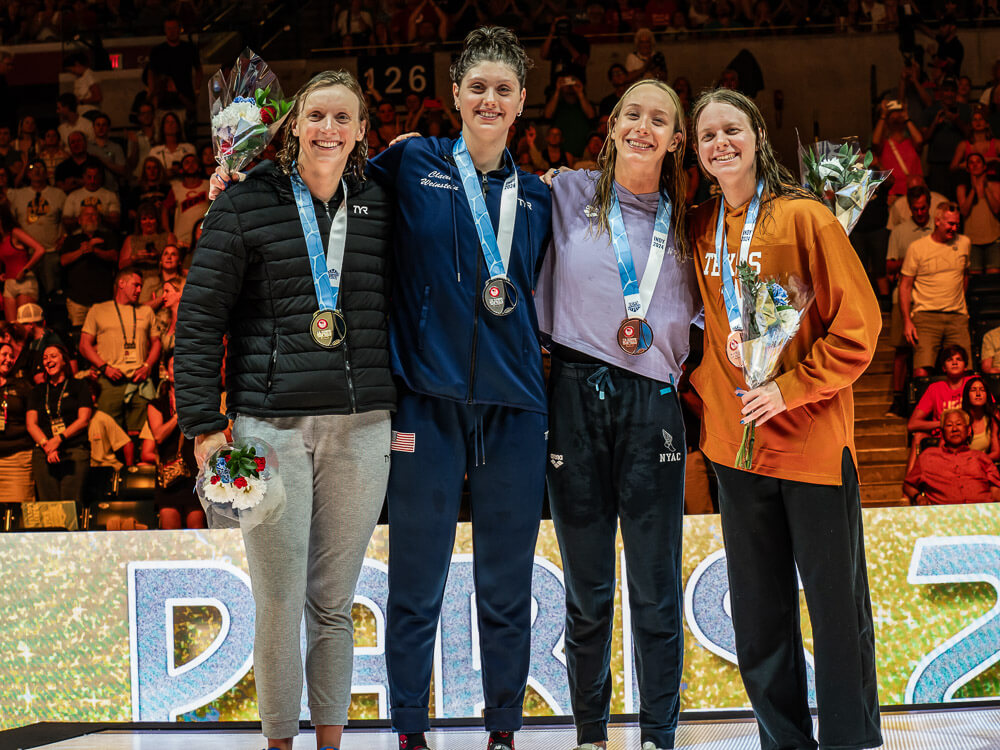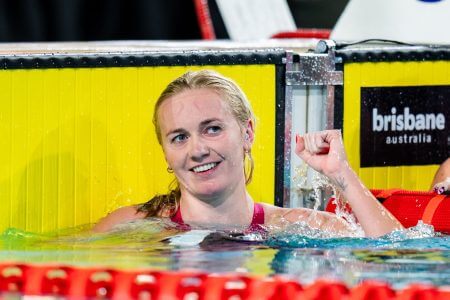Olympic Relay Analysis: U.S. Women Facing Huge Deficit in 800 Freestyle Relay

Olympic Relay Analysis: U.S. Women Facing Huge Deficit in 800 Freestyle Relay
At last year’s World Championships, the United States women took the lead over Australia with one leg remaining in the 800 freestyle relay. But the standings at that point were a mirage: the Americans had put all of their top swimmers on the front end of the relay while leaving rookie Alex Shackell to handle the anchor leg against 200 freestyle Olympic champion Ariarne Titmus. The results of that showdown were as expected, with the Aussies pulling away to win by almost four seconds and shatter the world record.
Entering the Paris Olympics, the deficit for the U.S. could be even greater after two Australian women both broke the world record at the country’s recent Olympic Trials, with Titmus clocking 1:52.23 and Mollie O’Callaghan, the previous owner of that record, going 1:52.48. Those two swimmers are clocked times more than one second faster than any other active swimmer.
And Australia’s depth is not too shabby either: Lani Pallister and Brianna Throssell both swam 1:55s at the Trials while Shayna Jack went that quick last year and was part of the record breaking relay in Fukuoka. Interestingly, Pallister is the only swimmer in contention for Australia who does not train at St. Peter’s Western under coach Dean Boxall.
The Americans, on the other hand, had two swimmers go 1:56 at the U.S. Olympic Trials, Katie Ledecky and Claire Weinstein. Yes, two under 1:56. Ledecky’s winning time at Trials was 1:55.22, a whopping three seconds shy of Titmus’ world record. Ledecky is surely capable of splitting 1:53 on a relay, as she has done in numerous high-pressure situations in years past, but that does not matter much when Australia’s top four times from just 2024 add up to one-and-a-half seconds under the existing world record.
Paige Madden and Erin Gemmell both clocked 1:56s in Indianapolis to officially secure their spots in Paris while Anna Peplowski and Shackell are likely to get onto the team as relay swimmers. In a significant surprise, the field did not include Bella Sims, who split 1:54s on American relays at the World Championships each of the last two years. Sims struggled mightily at Trials, failing to advance to the semifinals in the 200 free. Her absence from Paris creates a hole, with the U.S. coaches no longer having the dependable relay weapon at their disposal.
At this point, the best-case scenario for the United States is winning silver, but even that will be challenging considering the presence of strong teams from China and Canada. The Chinese were not expected to contend for gold three years ago in Tokyo when the knocked off both the U.S. and Australia, and Yang Junxuan, the world champion in the 200 free in 2022, while Li Bingjie was in 1:55-territory last year.
Canada will also return to the medal chase, but the team lacks the depth of years’ past with Penny Oleksiak and Taylor Ruck struggling and Kayla Sanchez having left to swim for the Philippines. Summer McIntosh is the world-junior-record holder in the 200 free and a serious medal contender in the individual event, but after her and the 1:55-cabable Mary Sophie-Harvey, there is a significant drop-off.

Ariarne Titmus — Photo Courtesy: Wade Brennan (Wade’s Photos)
Here is the composite relays, consisting of the four best times for each country using all results achieved in 2024:
Australia: 1:52.23 + 1:52.48 + 1:55.57 + 1:55.74 = 7:36.02
United States: 1:55.22 + 1:55.86 + 1:56.36 + 1:56.53 = 7:43.97
China: 1:54.38 + 1:56.29 + 1:56.56 + 1:56.85 = 7:44.08
Canada: 1:53.69 + 1:55.44 + 1:57.60 + 1:57.86 = 7;44.59
Based on those times, U.S. hopes of challenging Australia look non-existent unless injury, illness or something other unforeseen, unexpected circumstance befalls Titmus or O’Callaghan. A reasonable American goal might be earning silver and breaking the American record, the 7:40.73 a team featuring Ledecky and Madden along with Allison Schmitt and Katie McLaughlin clocked in Tokyo.
Reaching the record would require some serious improvements for the Americans over the next month, although such an outcome cannot be discounted. But without some drops, there is a serious risk of falling to third or potentially missing the medal podium entirely.

- EVENT PAGE
- SCHEDULE
- VENUE
- STREAMING INFO
- DAY 1 PRELIMS RESULTS
- DAY 1 FINALS RESULTS
- DAY 2 PRELIMS RESULTS
- DAY 2 FINALS RESULTS
- DAY 3 PRELIMS RESULTS
- DAY 3 FINALS RESULTS
- DAY 4 PRELIMS RESULTS
- DAY 4 FINALS RESULTS
- DAY 5 PRELIMS RESULTS
- DAY 5 FINALS RESULTS
- DAY 6 PRELIMS RESULTS
- DAY 6 FINALS RESULTS
- DAY 7 PRELIMS RESULTS
- DAY 7 FINALS RESULTS
- DAY 8 PRELIMS RESULTS
- DAY 8 FINALS RESULTS
- DAY 9 FINALS RESULTS




They will do the best they can.👍🏽👍🏽
I’ve worked online for $84, 8254 so far this year, and I attend school full-time. I’ve heard about an internet business opportunity that I’m employing, and I’ve made a ton of money. It’s quite easy to use, and I’m glad I learned about it. This is what I do.Please click this link for additional information. Thank you >>>>> joinwork7.blogspot.com
Certainly this is one event that minnow Australia is almost a lock against the behemoth of USA and China. Although it’d be amusing if the Might of Super Power US failed to medal in this event, but I think they still will win a minor medal.
Ofcourse they are now serious contenders in the 4×100m Freestyle and very strong to overwhelming favourites for the 4×100m Medley Relay.
Yeah, crazy how this race is for silver and bronze, unless the Aussies get DQ’d.
Same could apply to the Men’s equivalent,except it would be GB !
Or the US women in the medley relay, then Australia wins Gold.
doesnt AU need a breakstroker to being with? Right now they d be fighting for bronze if they can’t crack 1’06″8
That’s the Medley Relay.
But yes. DESPERATELY need a decent Breastroke leg in that one!